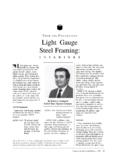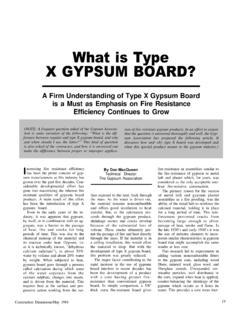Transcription of Light Gage Steel Framing - AWCI
1 FROM THE FOUNDATIONL ight gage Steel Framing : Use of theManufacturers literature From theContractors Perspectiveby Gary J. MaylonAbout the Author: Gary J. Maylonis manager of the Building ProductsDivision of Alabama Metal In-dustries Corporation (AMICO)where he has been employed for 13years. Prior to joining AMICO, was employed by WheelingCorrugating Company for five yearsand has been active in the marketingof Light gauge Steel Framing andmetal lath and accessories for hisentire professional is active with AWCI and theMetal Lath/ Steel Framing Associa-tion (ML/SFA) and currently servesas Vice Chairman of AWCIT echnical Subcommittee Number 5on Light gage Steel Framing andthe Task Force on is the third in a series ofarticles on lightweight Steel framingsystems.
2 Future articles will discusspanelization, estimating, welding,load-bearing and non-load bearinginterior and exterior wall systems aswell as joists in floor, ceiling androofing this age of increasing product anddesign liability, it has been our ex-perience that most designers andspecifiers are leaving nothing to years ago it was not uncommonfor design and load specifications to beleft in the hands of the contractor. To-day, however, the more common prac-tice is for the specifier to list the specificitems that make up the structuralframework and to list all pertinent in-formation necessary to bid and com-plete a job properly. This article will ad-dress the possible design criteria that thecontractor might use to bid and pro-cure Steel Framing jobs and how thecontractor can use the manufacturers literature to aid in this process.
3 We willlook at the information needed to sizejobs properly and to avoid errors discussing the use ofmanufacturer s literature, we must firstaddress the basic information contrac-tors must have at the start. Use of theliterature is not difficult once we knowwhat information is needed and whatinformation is typically found in FramingLoad BearingLet us examine the type of questionsyou, as a contractor, might needanswers to, in order to bid on a struc-tural Framing What type of load bearing stud isrequired or specified? Is it a C stud,a wide flange, or a channel stud? Thestructural C stud makes up the vastmajority of the load bearing studs soldtoday. There are several flange widthsoffered for the C studs and 1-5/8" makes up the majorityof what is sold, this product is availablein 2" and 2-1/2" flanges from In some parts of the country,coatings are still in question.
4 Shouldstud and track be painted or galvaniz-ed? Today, painted studs are almosttotally unavailable east of the RockyMountains. Most manufacturers supplygalvanized studs and track as a stan-dard product; in addition somemanufacturers offer aluminized steeland galvalume Steel which has a zincand aluminum Stud dimension should be address-ed next. Structural studs are availablein a wide range of web sizes, from 1-5/8"through 12".Construction Dimensions/December 1989 194. Another consideration in placing anorder is the actual length of each studneeded. Light gage Steel Framing can besupplied in lengths as needed for eachapplication, often to within 1/4" Lastly, we see occasions whendesigners and specifiers list the struc-tural items needed by certain designcriteria.
5 The designer might state thathe wants a 3-5/8" C stud that has a sec-tion modulus in excess of anda moment of inertia in excess of about the major axis. To the noviceStructural Framing : Wind Loadsthis sounds rather overwhelming, butall of this information is available frommost manufacturers literature. As youcan see in Figure 1, typically theliterature provides dimensional infor-mation on each individual web size, gage and in some cases, the type ofsteel, based on yield strength. Structuralsteel studs are available in yield strengthsof 33, 40, and 50 KSI (KSI = 1000pounds per square inch). Dimensionsare given for depth or web size, flangewidth and return lip, the weight perlinear foot, and the effective area insquare inches.
6 All of this informationis useful in comparing one manufac-turers stud with that of anothermanufacturer. Also typically listed arethe physical and structural properties ofeach stud. These properties are listedfor the major axis (x) which passesthrough the web of the stud at rightangles and the minor axis (y), whichpasses through the flange of the studat right angles. These include the mo-ment of inertia (Ix) and sectionmodulus (Sx). The moment of inertia(Ix) is used to compute a product s stiff-ness or resistance to deflection. Sectionmodulus (Sx) is similarly used to com-pute product resistance to stress. InTable 1, the 3-5/8" C stud describedearlier in terms of section modulus andmoment of inertia was a 3-5/8" 18 ga.
7 C stud with 1-5/8" in. will notice other informationlisted, such as (Rx) radius of gyrationas well as Sy and Iy, the sectionmodulus and moment of inertia aboutthe minor or y axis. Some manufac-turers also list several other physicalproperties. However, generally speak-ing the contractor will usually be con-fronted with nothing more complicatedthan the physical and structural proper-ties already you can see, when it comes tointerpreting manufacturers literaturedealing with structural properties, thereis no real mystery once the informationis contractor should understandthe subject of wind loads in stuck are used in two basicways: as load bearing studs that bearaxial loads-and/or wind loads, and alsoload bearing joists.
8 Studs that bear onlywind loads are not required to carry anaxial load (a load from above) and aregenerally called curtain wall studs. Thiswind or lateral force deflects or bendsthe stud toward the interior or exteriorof the building. This load must be con-sidered, not only because of the possi-Figure 1 Table 120 December 1989/Construction Dimensionsble failure of the stud, but also becauseof the effect of the deflection on thecollateral material attached to the studson the building s exterior. As shown inTable 2, the following information mustbe known in order to select the properstud to handle the appropriate windload for each job. First, we must knowthe appropriate wind load as specifiedin the applicable building code.
9 Noticethat a 25 pound per square foot windload is equivalent to a 100 mile per hourwind. Next it is important to know theMany contractors haveallowable deflection and the length ofthe stud. Stucco, for instance, usuallybecome so acquaintedrequires a maximum deflection rate ofL/360. If the stud length is 10'with the manufacturers(120/340 in inches) we would have adata and design pro-deflection of .333 inches or 1/3" in 10feet. This is derived by dividing thecedures that they havelength in inches by 360. It is helpful toinstilled much confidenceknow what size stud wall is planned,for example 3-5/8". In some instances, thein the may want as thin a wall aspossible to maximize floor space andeconomize on an exercise, let s say that we havea wind load of 20 PSF with a designcriteria of L/360 for a 16" stud spac-ing.
10 If we are trying to find a stud thatwill span at least 10' we simply followthe L/360 column under the 25 PSFheading down to discover that a 4" C stud 18 ga. will span a little practice, you will findthat this is a simple operation as longas all pertinent information is , most manufacturers list com-bined load tables. These tables considerthe effects of axial loads (dead and liveloads) combined with wind speaking these tables areTable 2designed for use by designers andspecifiers. Information in this section isusually listed in maximum allowableaxial load in KIPS (1000 lbs. per squareinch) per to the complex nature of theproduct, a great deal of information isrequired for structural studs.











